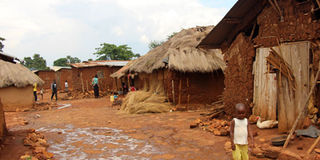Ilingira, the Buvuma island without a latrine

At risk. Homesteads at Ilingira Island in Buvuma District. Residents ease themselves in bushes and rocks. PHOTO BY DERICK KISSA
What you need to know:
- Attempts. Residents claim they pleaded with their leaders to construct pit-latrines but in vain.
- Ms Norah Atieno, a resident of Ilingira Peter Village in Buwooya Sub-county, says during the night, they walk at least 100 metres from their homes to ease themselves on a rock.
A traveller takes about 30 minutes on a boat to reach Ilingira Island in Buvuma District. As they step onto the island, they are greeted with a stench emanating from the shores of Lake Victoria while at a distance, children are swimming.
Despite being home to more than 2,000 people, the island does not have any pit-latrine.
As a result, residents resort to open defecation, exposing themselves to hygiene-related diseases such as cholera, typhoid and dysentery.
Ms Norah Atieno, a resident of Ilingira Peter Village in Buwooya Sub-county, says during the night, they walk at least 100 metres from their homes to ease themselves on a rock.
“Our children defecate near the shores and some of us walk to the rock and we ease ourselves, but when it rains, all the dirt flows to our houses,” Ms Atieno says.
“We pleaded with our leaders to construct at least one pit-latrine, but they last visited our island during campaigns,” she adds.
Mr Paul Musenero, another resident, says their children often get sick due to the poor sanitation.
“It is expensive to transport our ill children for treatment. If we had a pit-latrine, we would reduce the risk of contracting diseases,” Mr Musenero says.
More than 62 per cent of the population in Buvuma lack pit-latrines, yet according to the Public Health Act (2000), every homestead should have at least one.
Mr Titus Babu, the village chairperson, blames the top district leadership for not doing enough to improve sanitation.
“Our sanitation is very poor. People do open defecation on top of a rocky hill and when it rains, the place starts smelling and all the dirt flows in our houses, businesses and food that we keep outside to dry,” Mr Babu says.
“We mobilised Shs500,000 to dig a pit-latrine, but the money was not enough. If we do not swiftly get help, we will soon be hit by a deadly disease,” he adds.
The community depends on fishing as their main source of livelihood.
The district is made of a rocky terrain, which according to local leaders, makes it expensive to dig pit-latrines.
“So this requires a lot of money for a local person to construct pit-latrines in some part of the islands, which many people claim they don’t have. The only option is to construct temporary toilets and we ask government to help us on that,” Mr Alex Mabirizi, the district chairperson, says.
Buvuma comprises 52 islands, eight sub-counties and one town council.
Ms Harriet Nakizito, the health secretary, says they are sensitising residents about the value of using pit-latrines.
“We have tried to sensitise our people. They have a myth that if they use pit-latrines, they may not catch fish the following day,” Ms Nakazito says.
Mr Juma Kigongo, the deputy Resident District Commissioner, who visited the island recently, warned residents to build pit-latrines or their landing sites will be closed.
“I am shocked that these people still use the bush and rocks to ease themselves. I was going to close all the landing sites but I have given them the last warning. I will also talk to the district leaders to find a lasting solution,” Mr Kigongo said.
Pit-latrine coverage
Sanitation remains one of the key health issues in Uganda. Many people lack access to adequate sanitation facilities.
Available statistics also show that another 64 per cent (56,960) of the population lack access to safe water.
Reports indicate that the national average toilet coverage stands at only 68 per cent.
This means that almost seven homes out of every 10 lack pit-latrines.
A World Bank water sanitation programme report released in 2012 indicates that poor sanitation is costing the country at least Shs389b annually. Depending on depth and usage, each latrine takes not less than five years to fill, experts from Water Aid say.



